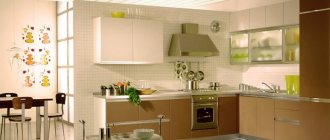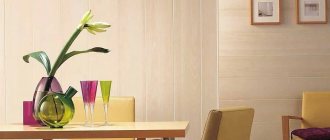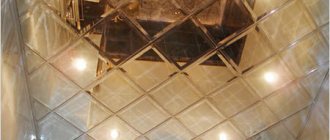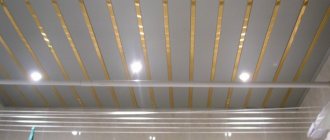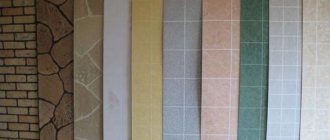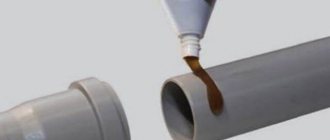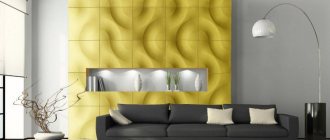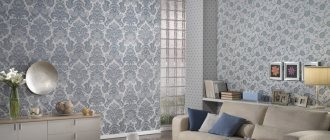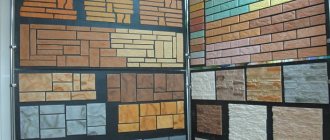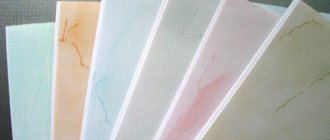What is MDF and panels made from it?
MDF panels are wood chips pressed into sheets. For decorative purposes, they are covered with a printed film and, as a rule, imitate various types of wood, less often stone.
For greater strength and resistance to moisture, they can be additionally impregnated with resins and antifungal components. Often, during printing, press embossing is also carried out: the panels acquire not only the color, but also the texture of the wood.
MDF for wall cladding is usually long panels that are easily cut and mounted end-to-end. Let us list the advantages and disadvantages of the material.
- Attractive appearance - thanks to it, the coating looks advantageous in any room. High-quality products can very accurately imitate natural wood.
- Durability - due to impregnation and a reinforced outer layer, expensive varieties are resistant to minor damage, for example, scratches from animal claws.
- Due to impregnations and adhesive resins, however, the panels can emit toxic substances (even in minimal quantities), so you should not install them in bedrooms and children’s rooms, and if installed, choose materials that have hygienic certificates.
- The structure (pressed sawdust) does not allow the panels to be used in damp conditions - bathrooms, bathrooms, spa areas, outdoors (internal cladding of terraces, loggias, balconies). Over time, they will “lead”, they will swell, and mold may grow in the thickness.
Illusion of space: 3D and mirror panels in the interior
A professional designer is always a bit of an illusionist: his task is to create the optical illusion of a bright, proportional and spacious apartment, even where the layout does not allow it.
Types of MDF panels
There are several types of MDF panels that differ in characteristics, production method and color variations. Depending on the production method, the following types of panels are distinguished.
Solid pressed panels
Smooth boards on both sides, which are made by pressing chips under high pressure and using high temperatures.
Laminated panels
They are produced in the same way as solid-pressed ones, but at the final stage of production the front side of the slabs is also covered with a polymer film. Thanks to this coating, the slab receives additional protection from mechanical damage and other influences. Film with any design, any color can be used.
Moisture-resistant panels
MDF panels, resistant to moisture, are made from denser material. High-quality wood is used for their production. These panels can be used to cover a bathroom or balcony.
According to the method of designing the front part, all MDF panels are divided into:
veneer panels, which in their texture and appearance are similar to natural wood. To achieve this effect, natural wood veneer up to 3 mm thick is applied to the surface of the slab;
laminated panels, the shiny and smooth surface of which is achieved by laminating the sheet with a polymer glossy or matte film;
painted panels onto which a special paint is applied, covering all texture irregularities and creating an ideal matte or glossy finish.
PVC (polyvinyl chloride boards)
PVC (polyvinyl chloride) is one of the types of plastics that is widely used as a finishing and structural material. More precisely, for these purposes it is not PVC itself that is used, but multilayer boards based on it.
One of the most common forms of PVC production is volumetric panels with an internal cellular structure, the so-called PVC lining. They are used in decoration, both internal and external. Such a wide range of uses is due to three important advantages of the material:
- Moisture resistance. The material is not damaged either by contact with air of high humidity, as in bathrooms, or by direct wetness. Both the structure and appearance of the panels are preserved;
- Easy to install and light weight. Placing PVC panels does not require the use of any special equipment, or even imparting load-bearing properties to the base due to the low weight of the finishing material;
- Varied design. The production technology of PVC panels allows you to give them absolutely any appearance - from imitation of wood texture or tiles to full-fledged photo printing.
At the same time, volumetric PVC panels (“lining”) have extremely low mechanical stability. They are easily damaged by any impact, covered with scratches and cuts. They also do not have load-bearing properties. But they can bend while maintaining performance characteristics.
However, PVC has a very important drawback - this material is not at all resistant to heat. Already at +60 degrees it begins to deform. But the main thing is that when heated, PVC releases harmful and toxic substances that enter the air and have poisonous properties.
As a result, PVC cannot be used when decorating children's rooms and kitchens, placed in direct sunlight or next to heaters or radiators. It is recommended to use this material with caution for lining pipes with hot water - although, of course, its temperature is usually 60-75 degrees.
PVC is not resistant to low temperatures. In frosts of -15 degrees and below, it becomes very fragile and breaks easily even with the weakest mechanical shocks. If internal tension was created in the PVC panels when covering the facade - for example, when fixing with self-tapping screws - then they may crack when it gets colder.
On the other hand, when used in the normal temperature range from -10 to +60 degrees, PVC panels are safe and convenient.
In general, PVC is characterized as follows:
- The base is a plastic plate (vinyl chloride polymer, 57% chlorine, 43% ethylene);
- The strength characteristics in any case leave much to be desired, but due to high wear resistance and ductility in the absence of mechanical shocks and similar damage, the panels can last forever;
- They have low environmental friendliness. Safe only when used in a certain temperature range (up to +60 degrees) and without contact with direct sunlight or heat;
- Well suited for use in bathrooms as they are resistant to moisture; It is better not to place them in kitchens and children's rooms due to the emission of harmful substances when heated.
The PVC used in finishing also has an attractive appearance. Its texture can imitate the natural shine of materials including varnished wood, ceramic slabs or natural stone. However, PVC panels for finishing facades are usually simply painted with light-absorbing paints in a uniform tone and cannot boast of such visual appeal.
Disadvantages associated with low environmental friendliness only appear if the PVC is heated. At room temperature this plastic is safe. In addition, it is odorless and does not irritate the skin.
Advantages
- Low price.
PVC panels are one of the cheapest finishing materials. The cost per square meter of “lining” ranges from several hundred rubles. In addition, their placement will also not lead to additional costs, since they do not require foundation preparation and are lightweight; Resistant to water and moisture. - Design variety. PVC panels can imitate the texture of wood, tiles, stone, be painted evenly, support photo printing, and so on;
- Easy to use. They do not require any super-reliable fastenings, have a certain elasticity and resilience, and can be placed by gluing, screwing or in siding-type guides;
Flaws
- Low mechanical strength. Easily damaged by impact and piercing-cutting influences;
- Low thermal strength. The recommended operating temperature range is from -10 to +60 degrees;
- Low environmental friendliness. When heated, PVC begins to release harmful substances.
It is worth mentioning that PVC is used in decoration, design and production of furniture extremely rarely. Typically, various additional substances are added to its composition, including plasticizers, softeners, heat stabilizers, softeners and even lead. All of them further increase the danger of the material - but only when heated, when the PVC structure is sharply destroyed.
Comparative characteristics of panels
When deciding which is better: MDF or PVC, you need to evaluate the parameters of each material.
PVC
Products made from polyvinyl chloride are made by extrusion: the mass is melted to a certain degree of plasticity, after which the raw material is squeezed out through special holes, acquiring the desired shape.
The final characteristics of the product are influenced by the composition. In addition to PVC, modifiers and stabilizers are added to the mixture, which give the product the required durability. Low-quality plastic elements are obtained from recycled materials. Their peculiarity is fragility and rapid loss of visual appeal.
High-quality polyvinyl chloride panels have the following advantages:
- Safety. The products do not contain components harmful to health, any possible fumes fully comply with the standards.
- Moisture resistance. One of the main advantages of the material. The elements are not damaged even in direct contact with water, and are also not prone to the appearance of mold and mildew.
Absolutely all plastic panels are moisture resistant; PVC cladding for bathrooms and kitchens is especially popular - Decorative. The coating is available in a wide variety of colors. The technology for obtaining the front layer consists of applying the desired composition to the surface using a special printing method, after which varnishing is carried out. Therefore, the coating can have a matte or glossy effect. Lamination can also be performed.
- Slight elasticity. As a result, parts can bend. Although the degree of such deformation is small, it allows you to level out small errors in the walls when laying directly.
- Additional sound insulation. The structure of the products has cavities that trap some of the noise.
Plastic panels have internal stiffeners and air cavities, which increases sound insulation characteristics.
Plastic panels do not require special skills during installation. Many manufacturers produce special fastening systems that reduce work time.
On a note! Plastic products that imitate the surface of brick or tile are in great demand. The cladding turns out to be very realistic.
MDF
Medium-density fiberboards are made from raw materials that are generated by grinding rejected logs of various tree species or by processing residues from the production of more expensive lumber.
The technological cycle is based on “dry” pressing accompanied by high temperatures. Urea resins are used as a binding element, but this does not affect environmental friendliness, so the product meets all standards.
In the production of classic MDF boards, no harmful components are used; the adhesive composition is natural glue lignin, which is released from wood dust at high temperatures
MDF panels have the following advantages:
- Strength. Due to the structure of the product, they can withstand mechanical loads well.
- Decorative. The external coating of parts can be formed by lamination (applying a special film under the influence of temperatures), lamination or veneering (a more expensive method). Among all types of finishing of MDF panels, the veneered version is considered the most expensive and beautiful, laminate is the golden mean, plastic film is classified as a budget finish, and lamination is simply pasting with paper
- Easy to install. The product does not require the use of complex equipment; most often, installation is carried out on a frame.
- Additional thermal insulation. Like any materials based on natural wood, slabs increase the energy efficiency of the room.
Elements made from MDF can withstand exposure to water, but for rooms with constant high humidity it is necessary to use a special type with additional impregnation.
On a note! Painted wood fiber panels have an excellent decorative effect.
Glossy automotive enamel on facing panels looks impressive, but the latest fashion in this direction is MDF finishing with 3D texture
Wide selection of door finishing materials
CATALOG OF DOORS IN VARIOUS FINISHES
After manufacturing the door leaf, finishing of the iron door begins. PVC is selected according to color and texture. If doors are prepared for sale according to an individual sketch of the customer, then operations are carried out in exact accordance with the sketch.
Typically, customers choose doors from an existing assortment of products. If they do not find all their desires and fantasies fulfilled in the finished product, or their future doors will be installed in non-standard doorways, then buyers, with the help of the plant’s specialists, draw up working sketches, according to which an exclusive door will be manufactured. When drawing up sketches, the finishing material and its color are especially discussed.
Many customers choose polyvinyl chloride (PVC) trim.
Thus, it can be emphasized that both materials compared have excellent consumer properties and are suitable for use on doors in any room. MDF is more environmentally friendly, so it can be used in rooms where safety requirements are increased.
Kitchen made of painted MDF
Painted MDF is one of the popular options among buyers. The main advantage of this type of material for making facades of kitchen units is a wide color palette in accordance with RAL, thanks to which you can choose almost any shade of facades according to the design idea.
Ease of care is another advantage of painted MFD, which is easy to clean and does not absorb dirt and foreign odors.
The disadvantages of enameled MDF include its rather high cost compared to kitchens made of plastic or acrylic. The paint that coats particle boards tends to fade over time, losing its presentable appearance.
Vulnerability to damage, as well as high visibility of fingerprints, can also be considered disadvantages of enameled MDF.
Typically, kitchens made from this material are chosen for mid-price kitchen design in private homes and apartments.
Which material to choose?
To correctly determine which type is best for use in a particular situation, you need to compare several factors.
Properties
High-quality products do not have a significant difference in the main parameters, but in some others there are significant differences:
- Fire safety. Both options refer to flammable materials that can support a fire. But PVC, when exposed to temperatures above 100 degrees, deforms and begins to release harmful substances, so it should not be placed near heating elements.
- Frost resistance. At subzero temperatures, polyvinyl chloride becomes brittle. Parts made from recycled materials will be particularly unstable.
- Availability. The cost of plastic products is somewhat lower, and they also have a larger decorative range.
The operational and aesthetic characteristics of MDF are somewhat higher, but plastic is much cheaper
Scope of use
When decorating the interior of a house or cottage, you should follow some recommendations:
- For showers and toilets, wall panels made of polyvinyl chloride would be an excellent solution.
- When decorating a bedroom, they give preference to MDF; this coating looks more noble.
- For a loggia or attic (if there is heating), plastic products are also a good option. They are combined with MDF parts, which are ideal for unheated balconies. The ceiling can be made of PVC.
- It is recommended to cover the corridor and hallway with fiberboards, as they are more durable.
- It is better to divide the kitchen into zones and use a combination of products.
- MDF coated with PVC film can be used for the manufacture of bathroom furniture and facades of interior items.
Thus, the choice of material should be based on the area of use and financial capabilities.
Which panels are best for the kitchen: tips for choosing
The fashion for decorating walls or backsplashes with ceramic tiles is slowly but surely becoming a thing of the past. Increasingly, we choose other materials - from economical MDF to glass panels that are unimaginable in their design.
What is the advantage of wall panels? Firstly, the ease of installation. If the tiles require smooth walls and several days to lay, then the panels can also be installed on rough walls. Secondly, it's a matter of cost. Ceramic tiles are not a cheap pleasure, but laminated or plastic products will save your budget. Let's look at the entire range of materials for decorating walls and decide which ones are best suited for the kitchen.
Definition
MDF - a material made from dried wood fibers treated with synthetic substances, is defined as an MDF profile.
The concept of MDF took its roots from the English language. And in simple words, this is a tile material formed by dry pressing of small wood chips at fairly high pressure and temperature.
PVC ( polyvinyl chloride ) - this type of material belongs to the group of thermoplastics. Thermoplastic, in turn, is the same plastic that remains recyclable even after the product is molded.
Methods of application
Polymer materials are a very popular finishing option; they provide neat facade decor and protection from many external factors. According to the method of application, PVC coatings are divided into the following types:
- Membrane-vacuum. The equipment used is a vacuum press, most often used for countertops, doors between rooms, cabinets, chests of drawers, bookshelves. Thickness - from a quarter to half a millimeter.
- Laminating. The process of gluing or pressing together two surfaces is called laminating. It is carried out using special equipment. It is used for various surfaces made of fiberboard and MDF, including window sills. The thickness of the cladding usually does not exceed three tenths of a millimeter.
- For lamination. Cladding is done on a machine because work is usually carried out on fairly long elements made of metal, plastic or wood in order to protect them from water and give them strength. Two-layer PVC film provides more complete protection from influences, including sun rays.
- Transparent. This type of material is very thin, almost like food grade, it does not perform its functions for too long, but it stretches well, and it is convenient to completely cover the product. Usually it is chosen for transporting something, securing it to the surface of the cargo with glue that does not leave any traces behind.
- For chipboard and MDF. Intended for individual parts, for example, ends. A special machine is used to stretch it, so it is difficult for a beginner to achieve good quality at home, although some craftsmen try to do this, using, for example, a hair dryer.
Film can be applied to surfaces in different ways:
- Laminating. This process has several subspecies, differing in temperature. Smooth elements are processed using the cold method, glue is applied to them, and then the coating is rolled under pressure. During warm processing, the glue is preheated to melt off excess water. The hot type of finishing is carried out at a temperature of 120-160 degrees, using heated rolling rollers.
- Lamination. In this case, no glue is used; the fastening effect is exerted by heat and pressure, which make the substance plastic. The result is a solid, non-delaminating fabric. Waste material is subject to recycling and reuse.
- Post-formation. The most effective option. The layered coating is applied to a base coated with glue on a positioning machine. The press used has a relief that gives the finished product an interesting texture.
Glossy PVC film is usually applied using a vacuum method.
Every technology has its limitations. For example, when laminating, it is imperative that the object be smooth, without protruding fragments or nicks. During post-formation, it must withstand the load that the equipment will place on it.
In general, polyvinyl chloride film for furniture facades is easy to use and has many advantages. It not only gives the furniture a glossy and presentable appearance, but also saves it from accidental damage and premature aging, chemical, thermal and other influences.
For chipboard and MDF
Membrane-vacuum
Transparent
High quality MDF panels in stock
At Remycom you can order high-quality MDF panels from popular domestic manufacturers: Kronostar, Eurostar and other brands. You can choose MDF boards of any type and color on our website, including those stylized to look like natural wood.
We offer you favorable prices for the entire range - from only 129 rubles per piece and convenient delivery conditions. We work directly with first-category manufacturers and dealers, so we guarantee the high quality of all products.
Advantages and disadvantages
Like any material for construction, medium-density fiberboard panels and PVC have a number of advantages, and maybe even a few disadvantages.
One of the first and most important advantages of medium-density wood-fiber panels is considered to be significant savings . After all, when compared with wood-based materials, the price of MDF is impressively lower.
This material also has the following number of advantages:
- Excellent resistance to temperature changes and high air humidity.
- No sagging due to its own hollowness.
- Resistance to various mechanical deformations and fungal damage.
But there are also disadvantages to panels of this type. Medium density wood fiber panel cannot be considered a durable material at all .
In addition, during use, the top part of their coating may wear off.
Speaking about this material, we can immediately take the example of common PVC windows.
There are also a large number of advantageous parameters in the use of PVC, namely:
- Great durability.
- Resistance to different types of atmospheric environments.
- Elegance in appearance.
- Tightness, which means a high level of thermal insulation and sound insulation.
- Ease of use. This profile is not restive in caring for it.
- Environmentally friendly and unconditionally harmless to humans.
The most necessary quality that polyvinyl chloride has is that it is a cheap, real material for thermal insulation.
Prestigious finishing options
In addition to the types of panels for kitchen walls described above, there are also other, more sophisticated and status options. Of course, the prices of such products are much higher, but they are worth it. It's not only a different atmosphere, but also a real highlight.
Natural wood
You won't find a more environmentally friendly option than natural wood. This type of finishing is the most expensive. The main advantage is the unusually status and respectable appearance of such finishing. The downside will be the difficulty of caring for the tree. It is problematic to wash it in order to leave the texture intact. And constant moisture does not spare such noble material. So the work area can very quickly lose its original appearance.
Wood kitchen decoration
Modern panels can be coated with a special substance (wax), which helps protect the material and extend its service life.
Tempered glass
Tempered glass panels are increasingly being chosen for wall decoration near kitchen units. It is worth noting that such glass can compete with ceramic tiles in terms of its performance. But glass can win here too. After all, tiles cannot convey the brightness of colors and the richness of the design.
Tempered glass panels - the height of perfection
You can apply any design you want to the glass. You can also wash it with any solution and not be afraid of damaging the structure. After all, the material is not afraid of mechanical stress.
Tempered glass panels are an ideal solution for wall decoration in the kitchen. In addition to one drawback - the very high cost. But they're worth it.
Any picture is available for glass
PVC as a universal coating
Modern PVC panels come in two types - with and without air chambers inside. They are widely used for both partial and full wall coverings. The main advantage is that the material does not absorb moisture, is easy to clean and can be installed in any room.
The main disadvantage is that printing on a surface can hardly be called reliable. It allows you to paint the interior, but will not create a high-quality imitation. In addition, over time, the print may fade and wear off (especially when it comes to chlorine-based disinfection solutions).
PVC panels allow you to inexpensively and efficiently decorate a bathroom, toilet, kitchen, or hallway. You can use them in other rooms, however, for example, in the bedroom and living room they will look uncomfortable. Thin panels made to look like ceramics allow you to easily make or replace a kitchen apron without any major labor costs.
Bedroom walls: 5 decorating tips
If bedroom walls could talk, what would they say? Perhaps: “We can hear the neighbor's TV at two in the morning” or “This shade of paint in the morning light looks different from the manufacturer's sample”? We are talking about finishing solutions that will definitely suit the walls in your bedroom.
Choosing the best wall panels for the kitchen - description and comparison
Decorating kitchen walls and splashbacks is becoming increasingly fashionable. This not only makes the design more interesting, but is also a very practical solution in many ways. It is worth noting that the use of tiles is becoming less and less common. Products made from MDF and glass panels are gaining more and more popularity. Find out which panels are best for the kitchen wall.
An interesting solution using panels
Direct differences between MDF and PVC
So, drawing conclusions and summing up, we can confidently name the distinctive features between these two materials. It should first be said that in terms of composition, MDF and PVC materials have nothing in common. These are completely two different materials. Let us note the significant differences between them:
- Price.
- Structure . One sheet of PVC is a common plastic material. MDF panel is a pressed wood material. The difference is immediately visible.
- Application . MDF panels are used mainly for finishing work indoors, and PVC is used for finishing both exterior and interior.
Of course, there are areas of application where MDF can directly intersect with polyvinyl chloride, for example, furniture production - in this case, MDF cladding is possible, and PVC can serve as decorative elements.
Prestigious finishing options
In addition to the types of panels for kitchen walls described above, there are also other, more sophisticated and status options. Of course, the prices of such products are much higher, but they are worth it. It's not only a different atmosphere, but also a real highlight.
Natural wood
You won't find a more environmentally friendly option than natural wood. This type of finishing is the most expensive. The main advantage is the unusually status and respectable appearance of such finishing. The downside will be the difficulty of caring for the tree. It is problematic to wash it in order to leave the texture intact. And constant moisture does not spare such noble material. So the work area can very quickly lose its original appearance.
Wood kitchen decoration
Modern panels can be coated with a special substance (wax), which helps protect the material and extend its service life.
Tempered glass
Tempered glass panels are increasingly being chosen for wall decoration near kitchen units. It is worth noting that such glass can compete with ceramic tiles in terms of its performance. But glass can win here too. After all, tiles cannot convey the brightness of colors and the richness of the design.
Tempered glass panels - the height of perfection
You can apply any design you want to the glass. You can also wash it with any solution and not be afraid of damaging the structure. After all, the material is not afraid of mechanical stress.
Tempered glass panels are an ideal solution for wall decoration in the kitchen. In addition to one drawback - the very high cost. But they're worth it.
Any picture is available for glass
Which is better: PVC panels or MDF panels?
Let's start with PVC, also known as Polyvinyl Chloride, a material known to many.
This colorless, transparent plastic does not burn in air and has low frost resistance. Panels made from this material are not afraid of water and high humidity. The moisture resistance of wall panels allows them to be used in rooms with high humidity, such as a bathroom. PVC is produced in such a way that pores and cracks do not form on the surface of the panels, in which unfriendly bacteria, mold and fungi can grow, and harmful insects cannot create nests for themselves.
